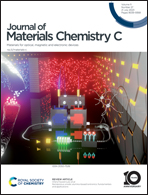Donor–acceptor polymer complex formation in solution confirmed by spectroscopy and atomic-scale modelling†
Abstract
In all-polymer solar cells, high performance is attributed to the fine-grained morphology of the film in the active layer. However, the mechanism by which this fine-grained morphology is achieved remains unknown. Polymeric non-fullerene acceptors have the potential to restrict the self-aggregation, typical of non-fullerene small molecule acceptors. Here we employed a blend of the polymeric acceptor PF5-Y5 and the donor polymer PBDB-T to investigate the balance between molecular interactions in solution. Temperature-dependent absorption spectra show evidence of temperature-induced disaggregation of both donor and acceptor polymers, where the donor polymer disaggregation depends on the solvent polarity. Concentration-dependent fluorescence spectra of blend solutions display blue-shifted acceptor emission upon dilution, similar to that observed in acceptor solutions, and a decreased tendency for charge transfer from donor to acceptor upon dilution. Excitation spectra of dilute blend solutions contain an increased contribution to the long-wavelength acceptor emission, as compared to pure acceptor solutions, from a chromophore that absorbs in a region where the donor does not absorb. These observations can be explained by donor–acceptor complexation in dilute blend solutions, that is stabilized in more polar solvents. Moreover, the near IR-region of the absorption spectrum could be matched with the calculated electronic excitations of donor–acceptor complexes of PBDB-T and PF5-Y5 oligomers. The results corroborate that the interaction between segments of the donor and acceptor polymer chains favours the formation of donor–acceptor charge transfer complexes, stabilized by hybridization of the molecular orbitals, which reduces the electronic energy. The proposed donor–acceptor complex formation competes with the donor and acceptor self-aggregation and is influenced by the solvent environment. These pre-formed donor–acceptor complexes in low-concentration solutions can be expected to have important consequences on the film morphology of all-polymer blends. The results from this joint experimental–theoretical spectroscopy study provide insights that can guide the design of compatible donor and acceptor polymers for future high-performance organic solar cells.



 Please wait while we load your content...
Please wait while we load your content...